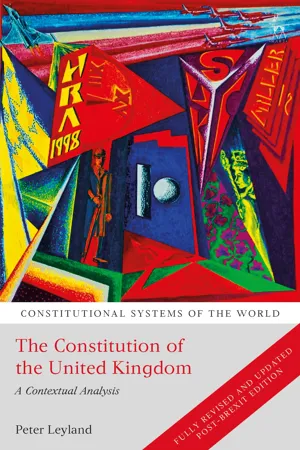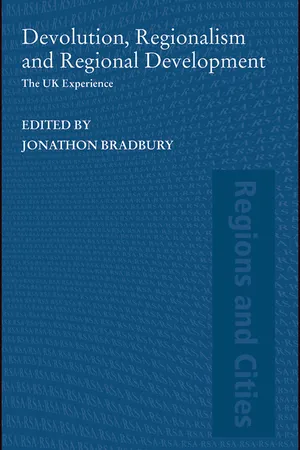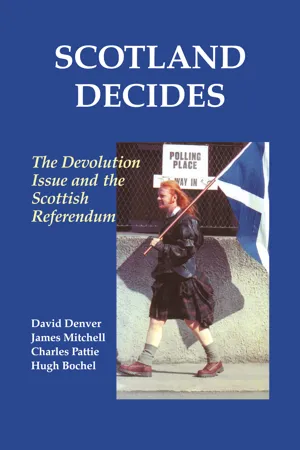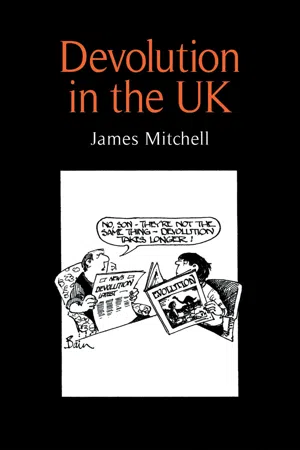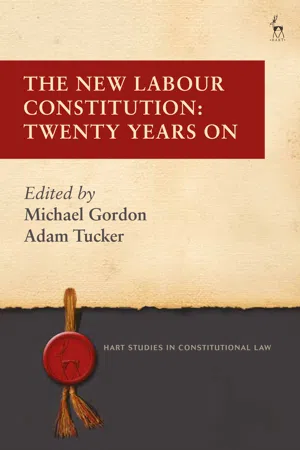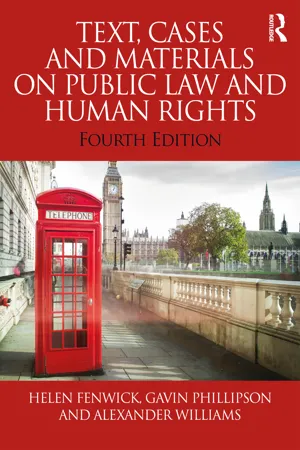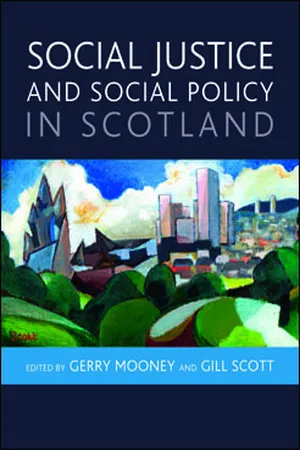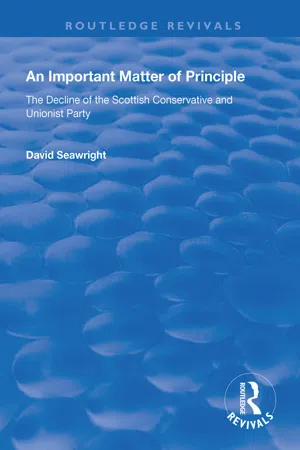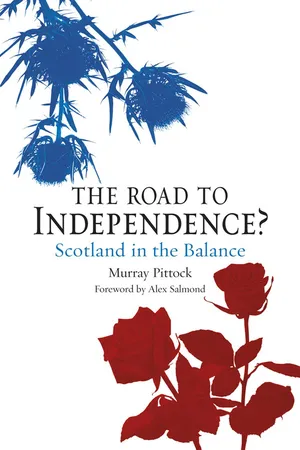History
Scottish Devolution
Scottish Devolution refers to the process through which Scotland gained its own parliament and government with devolved powers from the UK Parliament. The devolution of powers to Scotland began with the establishment of the Scottish Parliament in 1999, allowing for decisions on areas such as education, health, and justice to be made at the Scottish level, while certain powers remain reserved to the UK Parliament.
Written by Perlego with AI-assistance
Related key terms
Related key terms
1 of 4
Related key terms
1 of 3
10 Key excerpts on "Scottish Devolution"
- eBook - ePub
The Constitution of the United Kingdom
A Contextual Analysis
- Peter Leyland(Author)
- 2021(Publication Date)
- Hart Publishing(Publisher)
2 Varying degrees of power have been conferred on the devolved institutions in Scotland, Wales, and Northern Ireland as part of devolution; however, the continuing role of central government should not be underestimated. In a formal sense the Westminster Parliament has retained sovereignty and, until recently, it controlled the financial parameters of devolution by means of a block grant formula (see below).HISTORICAL BACKDROPDevolution was not part of a grand constitutional design; rather, the approach in each case needs to be understood in relation to the distinct history of each nation. Turning first to Scotland, the Crowns were united when James VI of Scotland succeeded to the English throne in 1603 as James I of England. The parliaments of England and Scotland were combined just over century later with each agreeing to an Act of Union in 1707. In legal terms the Kingdoms of England and Scotland were replaced by a United Kingdom of Great Britain. Although Scotland was represented in the Westminster Parliament, important aspects of the Scottish system were never integrated with England. For instance, Scotland retained its distinctive legal and educational system and separate Presbyterian church. In contrast, Wales has been closely linked to England from medieval times. The application of English law and administration in Wales, Welsh representation in Parliament, and the use of English as the official language were included in the so-called Act of Union of 1536; nevertheless, Wales retained its strong Welsh cultural identity and Welsh remained a living language. - eBook - ePub
- Jonathan Bradbury(Author)
- 2007(Publication Date)
- Routledge(Publisher)
Part IDevolution in the UKPassage contains an image
2 Devolution in Scotland
Change and continuity
Neil McGarvey
It was John Smith, the former Labour Party leader, in the early 1990s who first referred to devolution as ‘the settled will of the Scottish people’. By the time of his untimely death, devolution had moved from being a secondary to a primary issue on the Scottish political agenda. In 1997 it was endorsed emphatically in a referendum, and through eight years of Labour–Liberal Democrat governments, led by Donald Dewar (1999-2000), Henry McLeish (2000-2001) and Jack McConnell (2001-2007) the revived Scottish Parliament appeared to consolidate its centrality to the future of Scottish politics. In 2007, with the election of Scotland’s first ever nationalist administration led by Alex Salmond (as First Minister) the current devolution settlement is no longer looking so ‘settled’.The existing settlement, of course, stems from cross-party co-operation in the form of the Scottish Constitutional Convention (SCC) between 1989 and 1995. It was a body which allowed cross-party supporters of home rule a forum for discussion. The re-establishment of a similar type body was high on the agenda of Scottish politics after the May 2007 elections. The SCC’s final report—Scotland’s Parliament, Scotland’s Right (1995)—was part of the blueprint for the implementation of devolution in 1999. The SCC proposals were particularly influential regarding the electoral system and the issue of gender representation. In the words of Ian Lang, the former Secretary of State for Scotland, the SCC came:(Lang 2002: 174, 199)to form part of that congealing consensus that presaged constitutional change and eventually form(ed) part of the foundation of such change. By 1997 devolution had become a catalyst for all political opposition (to the Scottish Conservatives).Devolution has changed the institutional architecture of Scottish politics. The formal machinery and operation of democracy and government in Scotland is now, in David Steel’s phrase, ‘a world away from the old Scottish Office model’ (Steel 2001). The election of the minority SNP administration has accelerated that shift. Most accounts of devolution inevitably take as a starting point the institutional powers and resources of the devolved body in order to give a context for subsequent discussion. This reflects a long tradition in political analysis in general—there is an underlying implicit assumption that political institutions are important. - eBook - ePub
- Marina Dekavalla(Author)
- 2018(Publication Date)
- Manchester University Press(Publisher)
The brief overview of historical events examined so far lends support to the argument that tension in the nation’s relationship with the British union was primarily caused by differences relating to pragmatic considerations. Both devolution referendums in 1979 and 1997 can be seen as attempts by Westminster to compromise and cede some power over policy-making in order to keep the union together, but not complete power to fully satisfy demands. In both cases pressure for Scottish independence stopped for a while, but emerged again before long, prompted once again by pragmatic factors. In both cases, behind the pressure for independence lay a perception that there was a political disparity between Scotland and Westminster and a democratic deficit in how Scotland was governed. This fed into a general sense of difference between Scottish and English society.The fifteen years between the establishment of the first devolved Scottish parliament in 1999 and the 2014 referendum were marked by an impressive shift of the SNP to the forefront of the Scottish political scene. Devolution provided an opportunity for this to happen, because without the Scottish parliament the SNP would likely not have had the chance to get large enough numbers of Westminster MPs elected to share power, given that the Scottish vote is only one portion of the UK-wide electorate (Devine, 2016 ). Moreover, the SNP’s support was traditionally spread throughout Scotland and this did not allow it to gain seats in the electoral system applied in Westminster elections. The new system applied in Scottish parliamentary elections allocated additional ‘party list’ seats according to the proportion of the vote parties achieved and this initially helped the SNP win some extra seats. In addition to that, devolution created a new, clearly distinctive Scottish political scene, which allowed more space for the SNP to gain visibility (Johns and Mitchell, 2016 ). That said, devolution by itself did not guarantee the SNP’s rise – in fact the Scottish electoral system was set up so that a single party would not be able to easily achieve a majority and coalitions would be necessary. Devine suggests that ‘the structure had been carefully designed to ensure that nationalism would never threaten the union through achieving power in Holyrood’ (2016 - eBook - ePub
Scotland Decides
The Devolution Issue and the 1997 Referendum
- Hugh Bochel, David Denver, James Mitchell, Charles Pattie(Authors)
- 2013(Publication Date)
- Routledge(Publisher)
1Scottish Devolution: TheHistorical Context
INTRODUCTION
The referendum on Scottish Devolution held in September 1997, less than five months into the new Labour government's term in office, was the second to be held on this issue. Eighteen years before, in the dying days of the previous Labour administration, the Scottish electorate was asked to decide in a referendum whether, as proposed by the government, a Scottish Assembly should be established. A narrow majority of those who voted agreed that there should be an Assembly but this was not enough to overcome the qualification (that 40 per cent of the eligible electorate had to support the measure for it to be passed) which had been imposed by Parliament at Westminster. The change in the use of language between 1979 and 1997 is itself significant. By the time of the second referendum the debate was about creating a Scottish ‘Parliament’, not an ‘Assembly’. There were other changes which were more than symbolic, however. A substantial change of attitude had occurred among Scots although few home rulers could have anticipated this in 1979. Shortly after the first referendum, a cartoon appeared in a Nationalist newspaper. It showed a picture of a boy reading a book about ‘EVOLUTION’ with a picture of dinosaurs on its cover while his father was reading a newspaper with ‘DEVOLUTION LATEST’ on the front page. The caption below summed up the feeling of many supporters of Scottish Devolution at the time. ‘No son — they're not the same thing — devolution takes longer!’, the father explained.Although it was not until the 1970s that Scottish Devolution became a serious possibility, it could be argued that it was indeed a long time in coming. A Scottish Home Rule Association (SHRA) had been set up in 1886 and Scottish home rule was part of Keir Hardie's platform when he contested the Mid-Lanark by-election, as the first independent Labour candidate, in 1888. Hardie was supported by the SHRA although this later proved controversial within the organisation, as its secretary argued that the SHRA had been mistaken in backing Hardie (Mitchell, 1996: 71). This was only the first difficulty Labour was to have in a long history of relations with umbrella groups campaigning for a Scottish Parliament, up to and including the 1997 referendum. During the late nineteenth and early twentieth centuries, however, Scottish home rule was not an important issue in British politics. The Irish question was far more pressing and divisive and it had a considerable impact on Scottish politics. The issue split the Liberals to the great advantage of the Conservatives. The Scottish Unionist Party, initially a coalition of Conservatives and Liberal Unionists, was the official title of the Conservative Party in Scotland until 1965. Such was the relative importance of Scottish and Irish home rule, that the unionism expressed in the name of the party referred to the union between Ireland — later Northern Ireland — and Britain rather than to the constitutional position of Scotland. At the same time, while Labour in Scotland attracted strong support among Irish Catholic immigrants and there was much sympathy for Irish nationalism in Labour's ranks, this was not translated into support for Scottish nationalism. Indeed, Scottish Unionists and Conservatives often portrayed Scottish home rulers as in some way connected with Irish nationalism while Labour supporters, in the west of Scotland, often associated Scottish nationalism with the Orange Order and Irish unionism.1 - eBook - ePub
- James Mitchell(Author)
- 2013(Publication Date)
- Manchester University Press(Publisher)
7Devolution is a process: Wales Devolution is a process, not an event. (Ron Davies)Introduction
Even more than Scotland, the nature of the union between Wales and the rest of Britain has undergone significant change over a relatively short period of time. A historical overview is essential to understand why Welsh devolution today differs from that which exists in Scotland. What becomes clear is that while Welsh devolution is a pale version of that in Scotland, Welsh institutional development has been more dramatic. Wales demonstrates that while the past shapes the present, it need not dominate the future. Wales has had the advantage of having the Scottish precedent to follow. But the resemblances and precedents should not, in keeping with our understanding of the UK as a state of unions, be seen as the whole story. There is much that has been different and will remain so.The Welsh language and the constitutional status of Wales
Welsh nationalism was always more radical in its methods than its Scottish equivalent. In 1936, Saunders Lewis, founder of Plaid Cymru and one of the leading twentieth-century Welsh language activists, along with others set fire to a ‘Bombing school’ (a bombing range for training pilots) in Penyberth in a Welsh-speaking heartland. This ‘created a tradition of unconstitutional action’ (Davies 2007: 576). That campaign, like others which followed, combined pacifist and nationalist motives in combative, unconstitutional action. It gave rise to a notion of Welsh nationalism as defensive and ethnically-based, which in some forms it was, but at no time was this all there was to Welsh nationalism.The Welsh language was important in past debates on a Welsh Assembly. National identity had been the great mobiliser of opinion in Scotland where its inclusive nature gave it wide appeal, but it had a mixed effect in Wales. Welsh national identity was intimately related to, though far from synonymous with, the Welsh language. This provided it with an intense commitment but also restricted its appeal. The language became a divisive issue in the 1970s as Plaid became closely associated with its defence (Jones and Jones 2000: 258). There was a territorial dimension to the Welsh language as expressed in the Three Wales Model, derived from a 1979 Welsh survey of public opinion (Balsom 1985). Each of the three ‘primary social groupings’ Balsom identified had territorial ‘enclaves’. Y Fro Gymraeg - eBook - ePub
The New Labour Constitution
Twenty Years On
- Michael Gordon, Adam Tucker(Authors)
- 2022(Publication Date)
- Hart Publishing(Publisher)
There are, however, three caveats that might be added here. First, the political dynamics within each of the devolved legislatures have an actual or potentially distorting effect on the way in which policy debates about the reform of public services are framed and conducted. This is to say that the traditional assumptions that underpin parliamentary democracy – that it is grounded in a battle for ideas (left versus right, collectivism versus individualism, social democracy versus liberalism) and driven by a genuine contest for power that conditions, and is conditioned by, alternativee rule – have been displaced. So, in Scotland and in Wales, we see policy debates give way to constitutional questions about independence (in the case of the former) and about the evolution of the devolution settlement (in the case of the latter). The SNP in Scotland and Labour in Wales both dominate electorally, with little prospect of a meaningful contest for power any time soon. 94 It seems likely, then, that polarisation about devolution – a leftward pull towards independence; a rightward pull towards abolition or a more assertive unionism – will characterise the devolution debate in the next period rather than contestation within devolution about which parties should control the levers of power and to what policy ends. Second, the devolution of power to the devolved legislatures has yet to be (and shows little prospect of being) matched by a corresponding devolution from those institutions to local government. Local government in Scotland – which had been bitterly divided about devolution in the 1970s – was (largely) won over to the cause in the 1990s by the promise of a more cooperative and consensual relationship with the devolved institutions than had been enjoyed with successive Conservative governments in the 1980s and 1990s. 95 Two decades later, that promise – in Wales as much as in Scotland – remains unfulfilled - Helen Fenwick, Gavin Phillipson, Alexander Williams(Authors)
- 2020(Publication Date)
- Routledge(Publisher)
39 remains theoretically subject at the very least to express repeal by Westminster. However, with the UK constitution, it is always necessary to view it from two perspectives—legal and political—conventional. In terms of the latter perspective, a marked change has occurred. The UK Parliament, as a matter of expressly declared, and so far faithfully followed, constitutional convention is now a limited Parliament—it will not legislate in the areas devolved to Scotland without the consent of the Scottish Parliament. Further the Scotland Act plainly has a special status at the least as a matter of political fact—it will be impossible to repeal it or modify it in a way that reduces the scope of devolution without the consent of the Scottish Parliament. Moreover, the Scottish people are living, in relation to many areas of government, under what is in effect a codified constitution—the Scotland Act 1998 itself, which delimits the power of their legislature and Government and cannot be changed by them. Viewed through this second lens, devolution to Scotland has introduced what Bogdanor aptly refers to as ‘quasi-federalism’, ie a convention of federalism and a substantial degree of codification, to the UK constitution:[T]he relationship between Westminster and Edinburgh will be quasi-federal in normal times and unitary only in crisis times. For the formal assertion of parliamentary supremacy will become empty when it is no longer accompanied by a real political supremacy.40The relevance of the above for the traditional view of the UK constitution is discussed further in Chapter 1 , pp 21–23. As the foregoing indicates, there is a clear fracture in the devolution context between legal theory, according to which Parliament remains sovereign, and political reality, under which devolution to Scotland is virtually permanent. As appears below, ss 1 and 2 of the Scotland Act 2016, declaring the permanence of the Scottish devolved institutions and giving statutory recognition of the Sewel doctrine only widen the gap between legal theory and the reality, if not altering the legal position itself. Even before the 2016 Act, one author had argued that the above may come, in time, to undermine the legitimacy of the doctrine of parliamentary sovereignty itself as a key constitutional principle.41- eBook - ePub
- Gerry Mooney, Gill Scott(Authors)
- 2012(Publication Date)
- Policy Press(Publisher)
A repeated claim of those supporting devolution in the late 1990s was that it would allow the development of distinctively ‘Scottish solutions for Scottish problems’ (see Stewart, 2004; Mooney and Scott, 2005a). To quote Donald Dewar again, then in his pre-devolution role as Secretary of State for Scotland in the 1997 New Labour UK government:We have a proud tradition in Scotland of working to tackle social division. We have developed innovative responses to social problems, many of which are now being promoted within the UK as models of good practice. We have a body of people … who are committed to creating a fairer society in Scotland. And in the not too distant future we will have a Scottish Parliament, which will give us the opportunity to develop Scottish solutions to Scottish needs, and to bring the arm of government closer to the needs of the people. Devolution matters. It will let us take the decisions that matter here in Scotland. It is an end in itself: but it is a means to other ends, and none more important than the creation of a socially cohesive Scotland. (Scottish Office Press Release, 3 November 1998)From 1999 through to the early days of the fourth Scottish Parliament in 2011, there have been repeated claims to social justice on the part of successive Scottish governments. Further, and importantly, the two largest political parties in Scotland, the Labour Party and the SNP, also make competing claims as the inheritors of Scottish social democracy, infused with the language of social justice (see Keating, 2007b; Hassan, 2009). Devolution itself, and the re-establishment after almost 300 years of a Scottish Parliament, has been viewed as an exercise in social justice, addressing the so-called ‘democratic deficit’ (that successive Conservative-led UK governments from 1979 to the mid-1990s had been decisively rejected by the overwhelming majority of Scottish voters), and bringing forth a ‘new’ politics for the ‘new’ Scotland that was being forged (see Mooney and Scott, 2005b, pp 2-7; Tijmstra, 2009; Keating, 2010, pp 29-33). - eBook - ePub
An Important Matter of Principle
The Decline of the Scottish Conservative and Unionist Party
- David Seawright(Author)
- 2018(Publication Date)
- Routledge(Publisher)
6 Devolution, a Scottish Card?On Thursday the 11 September 1997 the people of Scotland overwhelmingly voted ‘YES-YES’ for a Scottish Parliament with tax varying powers. On a 60.4 per cent turnout, 74.3 per cent voted for a Scottish Parliament while 63.5 per cent agreed it should have tax varying powers. The Scottish Conservative and Unionist Party was firmly in the ‘No-No’ camp and the 25.7 per cent recorded on behalf of the constitutional status quo was uncannily similar to the party’s 1992 vote which was viewed at the time as a relatively successful robust defence of its constitutional policy. Much criticism has been levelled at this policy. Firstly, that it could only ever reach out to around a quarter of the electorate during the 1980s and 1990s. Secondly, it allowed the party’s political enemies, particularly in the media, to portray it as ‘Canute’ like, as puerile intransigence flying in the face of the wishes of the Scottish people. But as we shall see it is by no means clear that the Scottish Conservative Party’s electoral success has varied according to its position on devolution. Of course, the constitutional ‘status quo strategy’ may have reinforced the dreaded English identity - a point explored in greater detail in chapter 7 - but it is somewhat simplistic to suggest that the party’s electoral success and fortunes can be accounted for by its position on devolution.Devolution Equals Scottish Consciousness School
It is often argued that one reason for why the Conservatives were so successful in Scotland in the 1950s is that, although the party had no truck with legislative devolution, in practice it had done more than any other party to advance Scottish self-government since the creation of the Scottish Office in 1885. In particular, the inter-war period saw sweeping reforms culminating in the removal of the Scottish Office to Edinburgh in 1939. The Conservatives might be the unionist party, but it is claimed that they proved adept at playing the ‘Scottish card’ and received due electoral reward for it (for example, Miller, 1981 and Miller et al, 1981). This school of thought pervades the field of academic analysis on the Scottish Conservative and Unionist Party, particularly on the party’s decline. In short, the party is relatively successful when offering policies of administrative or legislative devolution in order to appeal to a Scottish consciousness. One clear example of this claim that the Conservative Party prospered when it advanced devolution is the following quotation from Miller (1981): - eBook - ePub
The Road to Independence?
Scotland in the Balance, Revised and Expanded Second Edition
- Murray Pittock(Author)
- 2014(Publication Date)
- Reaktion Books(Publisher)
24Centralization of powers is often taken to be a key measure of national sovereignty (another is, as Stephen Maxwell rather gloomily puts it, ‘the possession of an effective monopoly over the use of violence within the territory of a state’), but as we have seen in chapter One , elements of Scottish sovereignty, both in theory and practice, evaded centralization in a unitary state.25 Indeed, it can be argued that before 1707 (and even 1603) Scotland was used to distributed sovereignty: for example, many currencies circulated in the country, arguably more than in any other European state, as shortage of bullion compromised central government’s control of the exchequer.26 In its distributed sovereignty under the Union, Scotland was (as has been pointed out) a kind of avatar of the UK ’S role in the EU : indeed, just as with the eurozone, the Scottish economy took some time to adapt to the sterling zone after 1707, with price and wage convergence taking three quarters of a century in the cities, and longer still outside them.27In a Union which incorporated elements of distributed sovereignty and preserved elements of Scotland’s role as a state actor, what was seen as the re-establishment of the Scottish Parliament in 1999 (Winnie Ewing, its most senior MSP , described it as ‘hereby reconvened’ after a hiatus of 292 years) carried serious implications for traditional theories of British Parliamentary sovereignty, which are not yet worked through. This was not only because the Scottish Parliament had powers and could legislate, but also because the re-democratization of Scottish rights under the Union carried unanticipated implications. The Calman Report acknowledged the Scottish Parliament as, to an extent, a contemporary state actor, and subsequently the incorporation of much of his report in the Scotland Act 2012 (uniquely reviewed by both parliaments with gains and losses on both sides, of which the UK government’s refusal to devolve air passenger duty was perhaps the most important) implied the acceptance of the report’s radical constitutional language and the acceptance of the Scottish Government as a quasi-state actor by Unionist parties.28
Index pages curate the most relevant extracts from our library of academic textbooks. They’ve been created using an in-house natural language model (NLM), each adding context and meaning to key research topics.
Explore more topic indexes
Explore more topic indexes
1 of 6
Explore more topic indexes
1 of 4
